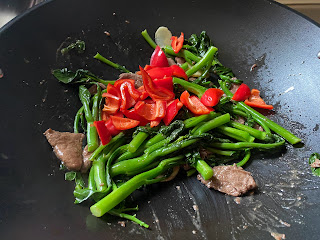This restaurant is located in the original Repulse Bay Hotel, where the place has already been re-developed into premium condominiums. However, this front-house building is preserved, with a historic vibe that spoke of the colonial times and remains one favourite spots for wedding and banquets.
We were seated at the window side looking out to the Repulse Bay and the dimming sunset. The meticulously dressed staff, the wooden beams and hanging fans on the roof, the silverwares on the table and the real candles, created a traditional Continental fine-dining experience.
After ordering a glass of Charles de Cazenove Brut NV ($168) to start, my wife decided to have the Boston Lobster Menu ($1,338) while I opted for The Repulse Bay Classic Menu with also wine pairing ($1,508). The first course for my wife was Boston Lobster with Kristal Caviar, neatly presented and delicious.
My first course was The Repulse Bay Caesar Salad, topped with shaved Parma Ham. The crunchy Roman lettuce had been seasoned beautifully with the signature salad sauce, authentic and original, with toasted pecans and croutons giving a nice bite. The ham was a nice touch as it wraps the lettuce with an extra layer of savoury delicacies. Although it looked easy, doing it right is not. The wine paired was Benanti Etna Bianco 2020 from Sicily.
Our second course was soup, with my wife having Bisque of Boston Lobster. While the big portion looked daunting as that could easily fill up half of most people’s stomach, the creamy texture and wonderful umami sweetness of the seafood essence won her over immediately.
It was the Traditional French Onion Soup for me. The steaming hot serving temperature was simply perfect, with the beef broth amazingly delicious. The baked Gruyere cheese croutons was another highlight, with the melting gooey cheese and the croutons absorbing the soup giving a ‘bite’ to the soup. This was one of the best onion soups I had tasted for a very long time.
For the main course, my wife had the Grilled Lobster Tail on Angel Hair Pasta. It was a generous portion with two tails served, along with some baby vegetables and a saffron foam. The angel hair also got a nice al dente texture and overall was another great dish she highly recommended.
There was a side story for me though. I had picked The Repulse Bay Black Pepper Steak originally, but the staff made a mistake and got me the Grilled Atlantic Salmon instead. While apologizing profusely and immediately went to get the steak done, they wanted me to also have the salmon. In the end, I got both main courses as a result.
The salmon was seasoned perfectly and very tender, having been slow-cooked before grilling, so enabling to keep its texture moist and soft by reducing the time on pan. With the truffle emulsion to add to the fragrance, even the chateau potatoes and wilted green asparagus on the side were all nicely prepared.
The steak was Australia OBE organic Angus beef tenderloin, very tender and cooked to my requested medium rare perfectly. Accompanied with glazed seasonal garden vegetables, gratin potatoes, black pepper sauce, it was quite good, but frankly I would pick the salmon over the steak in this case. The wine paired was Les Fiefs de Lagrange 2013 from St. Julien in Bordeaux.
For dessert my wife had picked The Repulse Bay Grand Marnier Souffle. It was another signature of the restaurant, fluffy and of appropriate sweetness. With a rich and delicious vanilla custard sauce and some fresh fruit on the side, it was a nice finale for the set.
I had the Baked Alaska Flambe instead. A theatrical presentation in which the flaming liquor was poured onto the whipped cream and ice cream cake underneath. The contrast in the warmed cream and the cold ice-cream inside was interesting, and the caramelized banana slices added some contrast in flavours and texture to complement. The wine paired was La Spinetta Moscato d’Asti Biancospino 2020 from Piedmont.
Finishing with Coffee and Petits Fours, the service was impeccable, with the staff attentive and courteous. Despite the mistake on the main course, the incident was well managed to avoid upsetting the customer which was commendable. The bill on the night was $3,531 and in my opinion reasonable. The manager had suggested us to try the summer menu featuring a tomahawk steak, which is offered at a very attractive price. Perhaps we should consider returning for that.



















































